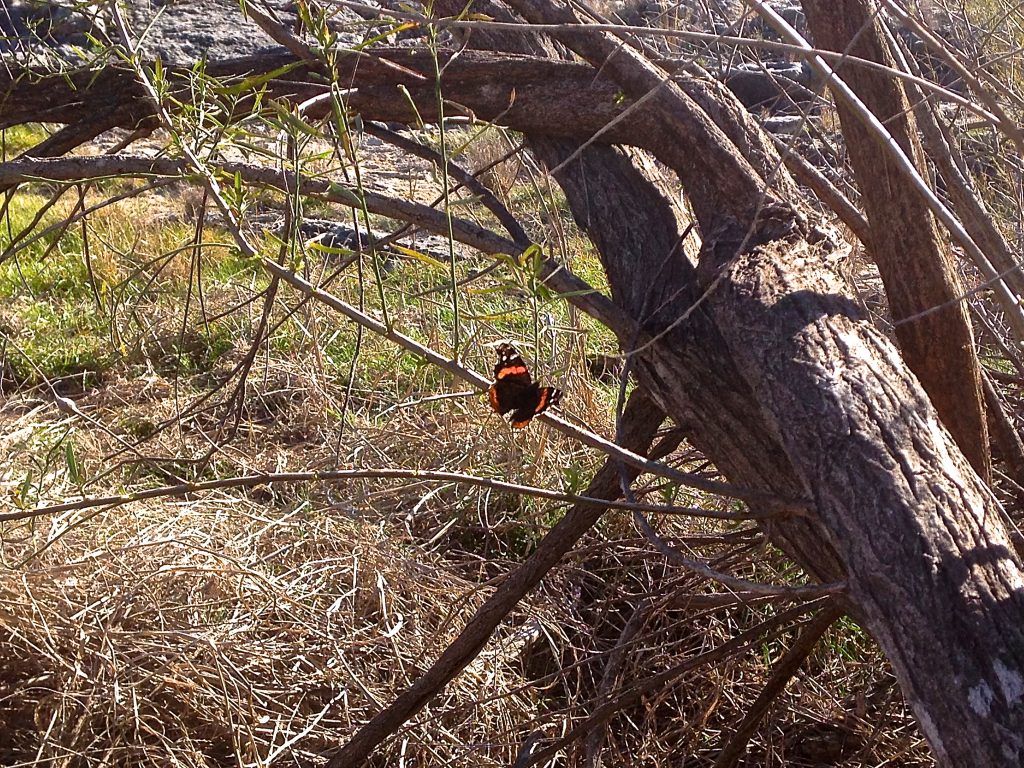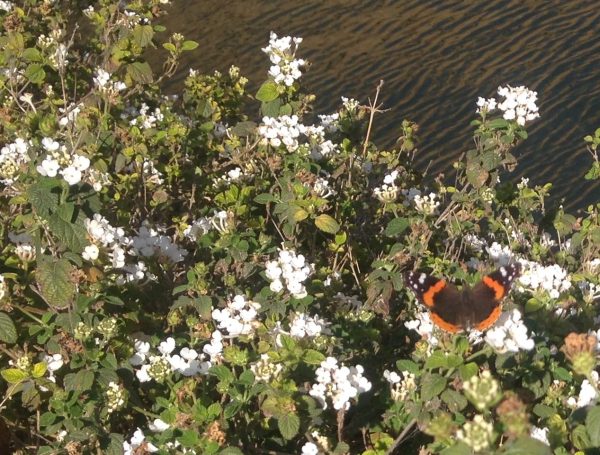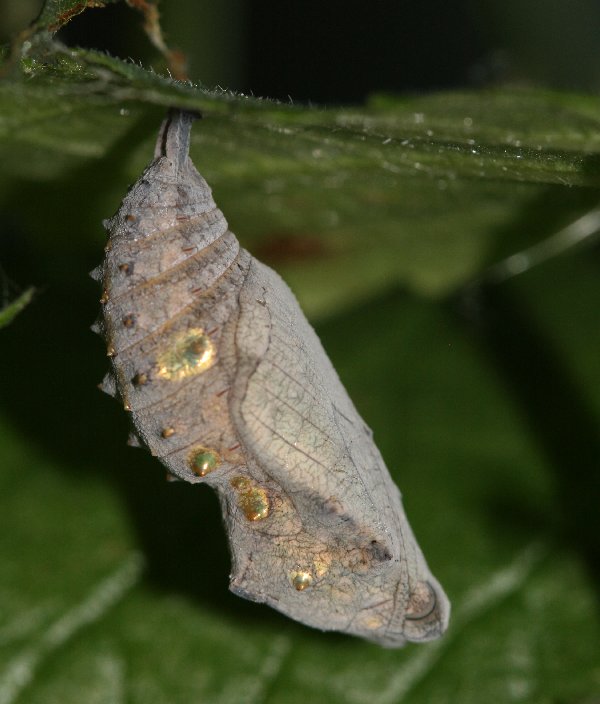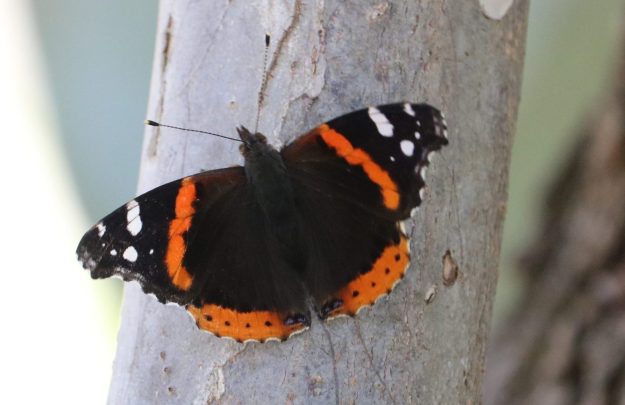With the sobering news of low monarch butterfly counts this season, it’s heartening to see the surge of another distinctive butterfly populating South Texas this month: Red Admirals, Vanessa atalanta.
The black-red-and-white insects flushed from the brush like so many happy campers along the Llano River last weekend, calling to mind last October when monarchs did the same.
Red Admirals are having a moment. Earlier this month, they were crowned New Zealand’s “Bug of the Year.” Much like our Pollinator Plant of the Year initiative, the Bug of the Year vote, staged by the Entomological Society of New Zealand aims to highlight underrepresented and unique species and inspire people to take an active role in their conservation.
New Zealand’s Red Admiral,Vanessa gonerilla, known in its home country as Kahukura–which means “red cloak” in the Maori language–is a different species from the one we see here in the U.S. The New Zealand species shows the butterflies white spots fringed with light blue near the tips of forewings.

Classic Red Admiral pose: resting on a tree limb. Photo by Monika Maeckle
In South Texas where they make a grand showing early each year, Red Admirals have black wings with a white stripe and a distinctive red epaulet when their wings are open; with wings closed, they sport a mottled look like their close cousin, the Painted Lady.
Red Admirals are unusual in that they prefer oozing sap, rotten fruit and even dung to flower nectar. Perhaps their preference for sap, made accessible to them by woodpeckers and yellow-bellied sapsuckers poking holes in trees, explains their penchant for hanging out on the edges of woods.

Red Admirals prefer sap, but they also nectar. PHoto by Monika Maeckle
They seem to be everywhere lately–lilting in the understory, resting in tree limbs, puddling on damp ground or sunning on warm rocks. They host on pellitory and members of the nettles family. In the caterpillar stage, they appear blackish-grey with white flecks and harmless spikes. Their chrysalis looks like a twisted, gold-dusted dead leaf.
According to Todd Stout, a butterfly breeder based in Utah, territorial males like to patrol and perch in the late summer afternoon, darting rapidly to chase down possible mates.

Red Admiral chrysalis looks like a dead leaf with gold flecks. Photo by Todd Stout, Raising Butterflies
Adults overwinter and migrate much like their Painted Lady cousins and have even been spotted congregating with Painted Ladies during hatches of the latter, said Stout. Check out Stout’s thorough account of the Red Admiral life cycle from egg to butterfly on his Raising Butterflies website.
Red Admirals also have a reputation as one of the “friendliest” butterfly species.
“Unmistakeable and unforgettable,” reads the description of Red Admirals in the National Audubon Society Field Guide to Butterflies of North America. “The Red Admiral will alight on a person’s shoulder day after day in a garden.” Stories of the small butterflies landing on shoulders, hats and fingers, “riding” with humans are not uncommon.
Connie Hodsdon, a commercial butterfly breeder and owner of Flutterby Gardens of Manatee in Florida, once told me that none of the many species in her massive butterfly garden is as friendly as Red Admirals.
Hodsdon relayed that she once was talking with a friend and pointed to a Red Admiral in her butterfly garden. “It landed on my finger,” said Hodsdon, who has been breeding butterflies for research, education and celebrations for more than a decade.
“When I reached for it with my other hand, it flew off. Thinking that what had just happened was a fluke, I put my finger out again and the butterfly came back and landed. This time, I just walked it back to the flight house and it rode on my finger all the way. ”
Hodsdon added that you can watch Red Admirals “cleaning their feet,” as the sap makes them sticky.
Entomologist Chip Taylor, founder of Monarch Watch, suggested the reason Red Admirals seem friendly is that since they like sap, they are also attracted to sweat on your skin. “That’s why they like you,” he said.
TOP PHOTO: Red Admiral on persimmon. –Photo by Lee Marlowe
Related posts:
- Clammyweed named 2024 Pollinator Plant of the Year
- Pollinatives, San Antonio’s second native plant nursery, results from couple’s retirement “deal”
- Mostly native urban pollinator garden outperforms lawn every time
- Flower “bed” works overtime as bachelor pad for solitary bees
- Trinational friendship garden woos pollinators and their fans to Confluence Park
- Doug Tallamy proposes crowdsourcing a homegrown national park: Who’s in?
- How to plan a successful butterfly and pollinator garden
- Mostly native butterfly garden outperforms lawn every time
- A year in the life of an urban butterfly gardenDowntown River walk plot converts to pollinator garden, creature haven
Like what you’re reading? Don’t miss a single article from the Texas Butterfly Ranch. Sign up for email delivery at the bottom of this page, like us on Facebook, follow us on Twitter, @monikam or on Instagram.


I remember in 2012 we had an unusually large “flight” of red admirals. A friend and top entomologist in Iowa Nathan Brockman, wrote an article about red admirals and what can cause this spike in the population to occur or not. https://hortnews.extension.iastate.edu/2012/5-2/redadmirals.html
Red admiral butterfly seen in Michigan just now. At least 3.
Lots here in South Texas right now! 🙂 Our back yard seems to be a favorite location. We do have woodpeckers, don’t know (yet) about pellitory/nettles (maybe).
Spotted a Red Admiral butterfly today in Chicago area today (04/19/24).